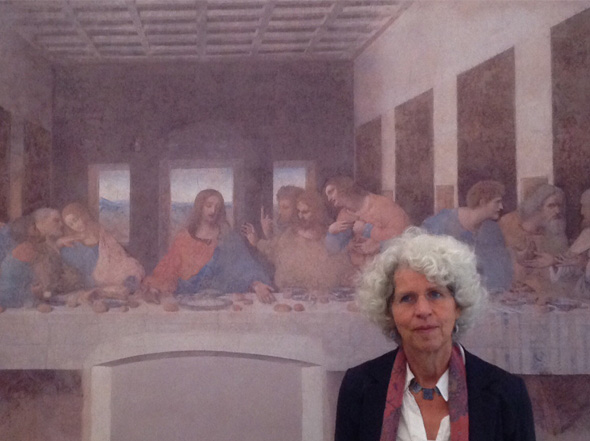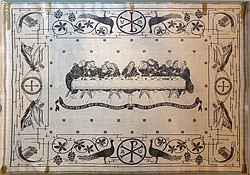History of The Last Supper

Masterpiece in Milan
The Last Supper, painted by Leonardo da Vinci between 1495 and 1497 for the refectory of the Convent of Santa Maria delle Grazie in Milan, was an instant success among his contemporaries. What a masterpiece! Never before had the gestures and emotions of the disciples been painted in such a lifelike way. Leonardo painted the disciples as people, no different from anyone who you might meet on the streets of Milan. Real people, people of flesh and blood, people like you and me. And Leonardo did not paint the moment that was usually portrayed, when Jesus broke the bread. No, Leonardo chose the dramatic moment in which Jesus said: ‘One of you will betray me.’
Furious gestures
The disciples react furiously with many different gestures and responses. There is shock, horror, surprise and disbelief. It can’t be true! Why would he say such a terrible thing? To the left, we see Bartholomew leaping furiously out of his chair. The disciples to the right of Jesus also show strong emotions. Only John, to the left of Jesus, seems with his folded hands and downturned eyes to be sunk in contemplation. Did he not hear the terrible words that Jesus spoke? Do they not apply to him? That certainly is not the case for Judas, who sits next to John, leaning back in shock and with the purse of money containing the traitor’s reward in his right hand. And he knocked over the salt cellar too, how stupid! How does Jesus know that he betrayed him? Incensed, Peter thrusts his head forward between Judas and John. What? Betrayed? Who? His arm in his side, who would dare! Whoever it is, he’ll teach them a lesson they won’t forget! In his right hand, he flashes the knife that he will later use to chop off the ear of a soldier.
The calm of a laid table
The disorder at the table is in huge contrast with the calm of the laid table. This is Leonardo’s interpretation of the event. It all looks so beautiful; it really is a picture. The more than six-metre-long white linen tablecloth with blue stripes covers the trestle table. Of course, the table has been covered with white linen. No one would eat from a rough wooden table! It is lucky that there was such a beautiful long tablecloth that they could use. Look how cleanly the sharp folds form a regular rythmn in the tablecloth. Leonardo has tied knots in the corners of the cloth, so that it does not fall to the ground and get dirty. Or could it be a reference to his name? He has a good sense of the right etiquette. See how it exudes a sense of calm, such a fine white tablecloth. And there is enough to eat, there is bread and fish for everyone and a good glass of wine.
And there they are then, that’s the end of the good time they were having at the table. Traitor? One of them is a traitor? But who? Good Lord, how will this end?
Source of inspiration
Leonardo da Vinci’s The Last Supper has long been an inexhaustible source of inspiration for painters, engravers… and weavers. Of all his works of art, this is the one that has been interpreted and imitated in so many ways. Soon after, a full-size copy was even made for the convent at Tongeren in Belgium. Dozens of engravings were also produced, and it was converted into other forms, from wooden carvings to silver plaques and cross-stitch embroideries.
The Last Supper damask
Starting in 1850, Dutch manufacturers also incorporated the design into damask that was used in the church and at home. It was made for both Catholic and the various Protestant churches. At the National Exhibition in Haarlem in 1861, there was even a silk tablecloth depicting Leonardo’s The Last Supper on display.

In the 20th century, Gerard Johan Burgers, owner of the Van Hoogerwou weaving mill in Boxtel, visited Milan and Tongeren to see The Last Supper, after which he made a new drawing that was used to create a pattern for weaving in damask.
Sanny has five different tablecloths depicting The Last Supper in her private collection. That means that a lot of effort was made on five separate occasions to transfer the design to woven fabric. For Sanny’s Dutch Design Damask collection, Willem van ’t Riet created a new design in 2012 that has again been woven in The Last Supper damask.
